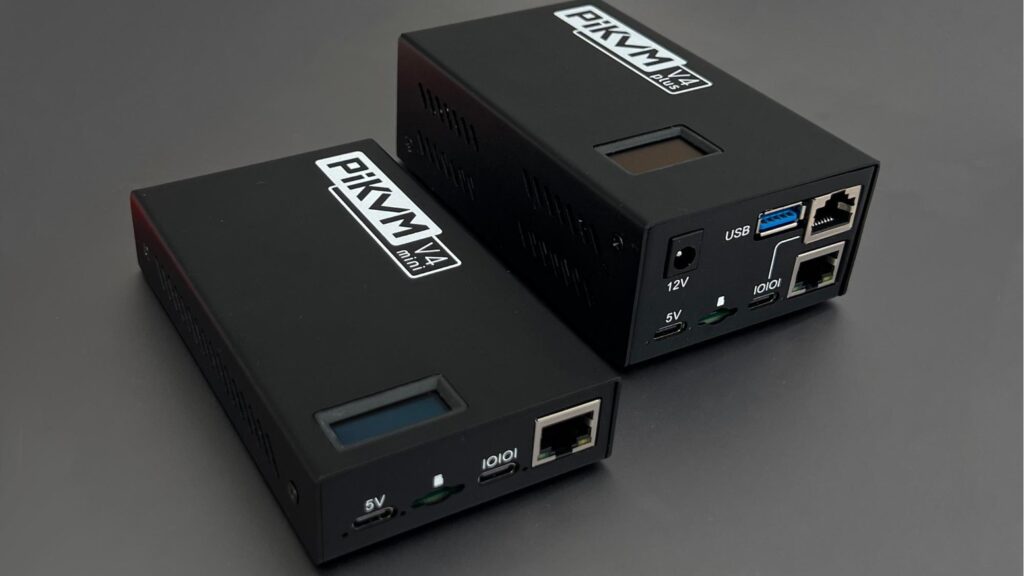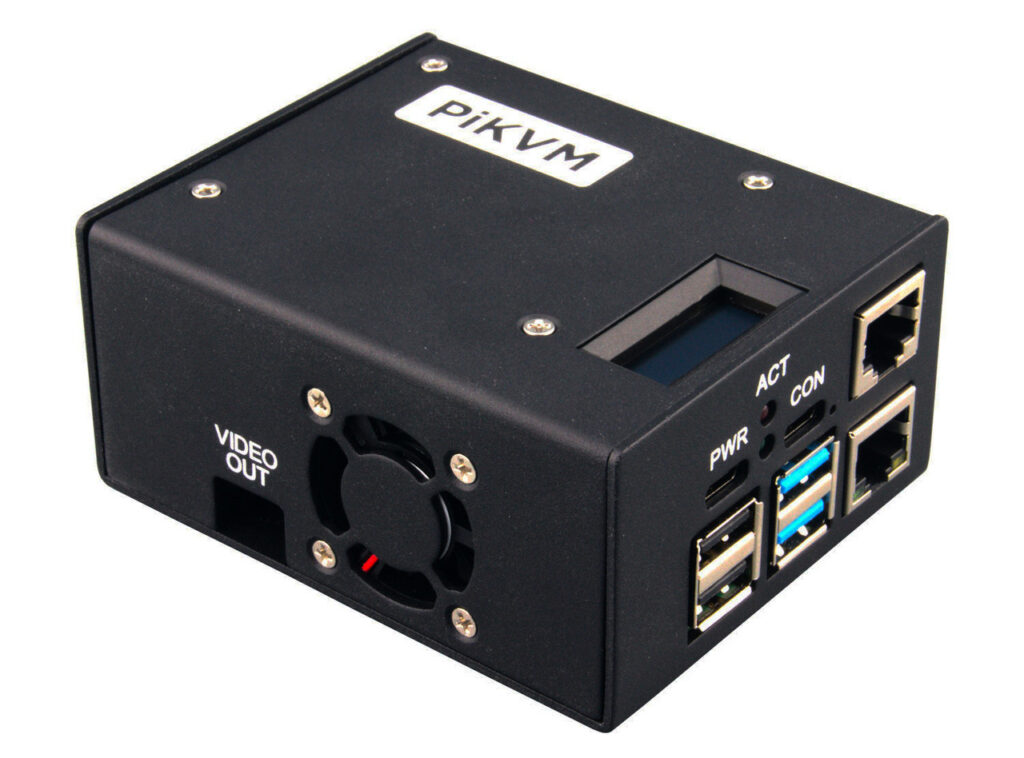Any links to online stores should be assumed to be affiliates. The company or PR agency provides all or most review samples. They have no control over my content, and I provide my honest opinion.
Remote server management has traditionally been the domain of expensive enterprise solutions. However, a new generation of affordable KVM (Keyboard, Video, Mouse) over IP devices has emerged, making remote management accessible to enthusiasts, small businesses, and home lab operators. These solutions allow users to control computers remotely, even at the BIOS level, without requiring physical access or host software installation.
As someone with a growing homelab of mini PCs living in my loft, I have been looking for an affordable way to manage my computers for general maintenance without having to physically go into my loft and plug a monitor/keyboard/mouse in.
This article examines several cost-effective KVM-over-IP options that provide functionality previously only available in high-end enterprise equipment. From the open-source PiKVM to commercial alternatives like TinyPilot and emerging options such as JetKVM and NanoKVM, there are now numerous choices for remote system management at various price points.
What is KVM over IP?
A KVM over IP device allows you to remotely control computers via a network connection. Unlike software-based remote desktop solutions, these hardware devices:
- Function independently of the host operating system
- Provide access to BIOS/UEFI settings
- Allow remote power management
- Enable OS installation via virtual media
- Work even when the target system is powered off or experiencing issues
These capabilities make KVM over IP solutions invaluable for server management, particularly in headless setups or remote locations where physical access is limited or impractical.
PiKVM: The Open-Source Pioneer

PiKVM has established itself as the leading open-source KVM over IP solution, built around the Raspberry Pi platform. It offers enterprise-grade features at a fraction of the cost of commercial alternatives.
Key Features
- Browser-based interface: Access your systems through any modern web browser without proprietary clients
- Low latency: Approximately 100ms video latency for responsive remote control
- Virtual media: Mount virtual CD-ROMs or flash drives for OS installation
- ATX power control: Remotely power on, off, or reset connected systems
- VNC support: Connect via standard VNC clients in addition to the web interface
- Security: SSL encryption and authentication to protect remote access
PiKVM Versions
PiKVM is available in several configurations:
PiKVM v3 HAT
- A HAT (Hardware Attached on Top) for Raspberry Pi 4
- Requires assembly with a Raspberry Pi 4
- Available from retailers like Pimoroni for around £100 (plus Raspberry Pi)
- Full HD HDMI capture based on TC358743 chip
PiKVM v4 Mini & Plus
- Pre-assembled, ready-to-use devices
- V4 Mini uses USB-C 5V power, Plus uses 12V barrel connector
- Built-in display for status information
- Metal case for durability and EMI protection
- V4 Plus offers HDMI passthrough functionality
- Higher price point than the DIY v3 option
The PiKVM v3 HAT can be purchased separately (around £100) and paired with a Raspberry Pi 4, or as a complete kit including the Pi, case, and accessories. The v4 models come pre-assembled in a metal case with a built-in display, with prices starting around £300-350.
DIY vs Pre-built
While the DIY approach with the v3 HAT offers cost savings, the pre-built v4 models provide a more polished, production-ready solution. The choice depends on your budget, technical comfort level, and need for additional features like HDMI passthrough (v4 Plus only).
TinyPilot: Plug-and-Play Simplicity

TinyPilot offers a commercial alternative to PiKVM, focusing on ease of use and a polished user experience. It’s built on similar technology (Raspberry Pi-based) but comes as a ready-to-use product with professional support.
Key Features
- Plug-and-play setup: Pre-configured system with minimal setup required
- Browser-based interface: Clean, intuitive UI requiring no additional software
- Virtual media support: 32GB microSD storage for ISO files and virtual drives
- Low power consumption: Energy-efficient design with power draw similar to a Raspberry Pi
- Commercial support: Professional backing and regular updates
TinyPilot Models
The current flagship model is the TinyPilot Voyager 2a, priced at $399 (approximately £300). Optional add-ons include:
- Power over Ethernet (PoE) adapter: $99
- HDMI to VGA adapter: $14.99
TinyPilot represents a middle ground between DIY solutions and enterprise KVMs, offering a balance of affordability and polish with commercial support.
JetKVM: The Newcomer

JetKVM is a relatively new entrant to the KVM over IP market, launched via Kickstarter. It aims to provide professional features in a compact, durable package at a competitive price point.
Key Features
- Independent operation: Functions without host software, even when the target computer is off
- Wake-on-LAN: Remotely power up compatible devices
- Virtual disk mounting: Mount disk images for OS installation or file transfer
- Low latency: High-definition 1080p video at 60 FPS with 30-60ms latency
- Durable design: Die-cast zinc alloy body for durability
- Optional cloud access: Remote access via JetKVM Cloud using WebRTC (not mandatory)
JetKVM is available through Kickstarter with prices starting from $69 (approximately £55), with estimated delivery in December 2024. The device offers a compelling feature set for its price point, though as a crowdfunded project, it carries the typical risks associated with such ventures.
Sipeed NanoKVM: Compact and Affordable

Sipeed offers several KVM solutions, including the NanoKVM-USB and NanoKVM PCIe models. These RISC-V-powered devices provide a compact and cost-effective approach to KVM over IP.
NanoKVM-USB
- Compact design: Measures just 55x22x25mm in an aluminium case
- Browser-based interface: No proprietary software required
- USB 3.0 connectivity: Simple connection to host systems
- MJPEG encoding: 1080p video with 100-150ms latency
- Virtual HID: Keyboard and mouse emulation
- Virtual ISO: Switchable USB-A for mounting disk images
- Price: $39-49 (approximately £30-40)
NanoKVM (Cube)
- Based on the LicheeRV Nano single-board computer
- Uses Sophgo’s SG2002 chip with RISC-V architecture
- 1080p60 MJPEG video streaming (H.264 in development)
- Available in “Lite” ($22) and “Full” ($43) configurations
- Full version includes OLED display and ATX power control
The NanoKVM options stand out for their extremely competitive pricing, making them among the most affordable KVM over IP solutions available. The trade-off comes in the form of fewer features compared to more expensive alternatives.
Geekworm KVM Solutions
Geekworm offers several KVM solutions designed to work with Raspberry Pi, including standalone modules and integrated systems.
Geekworm KVM-A3
| Preview | Product | Rating | Price | |
|---|---|---|---|---|

| Geekworm KVM-A3 Kit for Raspberry Pi 4 Open Source KVM Over... |
£79.89 | Buy on Amazon |
- External KVM module compatible with Raspberry Pi
- Supports ATX power control for direct hardware power management
- Includes data-only USB cable for safe keyboard/mouse emulation
- Cost-effective option at around £80
- Works with Raspberry Pi 3B or 4
Geekworm X680
| Preview | Product | Rating | Price | |
|---|---|---|---|---|

| Geekworm KVM-A8 PCIe Version for Raspberry Pi 4 Model B KVM... |
£92.89 | Buy on Amazon |
- Integrated multi-port KVM solution
- Supports controlling multiple servers from a single device
- Includes remote power and reset control functionality
- More compact cabling than individual PiKVM setups
- Potential compatibility issues with some graphics drivers
The Geekworm options are particularly well-suited for managing multiple servers, with the X680 offering an integrated solution for controlling several machines from a single device.
Comparison of KVM over IP Solutions
| Feature | PiKVM v3/v4 | TinyPilot | JetKVM | NanoKVM | Geekworm |
|---|---|---|---|---|---|
| Price Range | £100-350 | £300 | £55 | £30-40 | £80-150 |
| Video Resolution | 1080p | 1080p | 1080p60 | 1080p60 | 1080p |
| Latency | ~100ms | ~100ms | 30-60ms | 100-150ms | ~100ms |
| Virtual Media | Yes | Yes | Yes | Yes | Yes |
| ATX Power Control | Yes | No | Yes | Yes (Full) | Yes |
| Pre-assembled | v4 only | Yes | Yes | Yes | Varies |
| Open Source | Yes | No | Partial | No | No |
| Multi-port | With add-ons | No | No | No | X680 only |
Use Cases and Considerations
Home Lab Management
For home lab enthusiasts, KVM over IP solutions offer several benefits:
- Remote access: Control servers from anywhere in your home
- Space efficiency: No need for dedicated monitor, keyboard, and mouse
- Power management: Schedule shutdowns to save energy and remotely power on when needed
- OS installation: Install or reinstall operating systems without physical media
PiKVM or Geekworm options are particularly well-suited for home labs, with their open-source nature allowing for customisation and integration with other systems.
Small Business Server Management
Small businesses can benefit from affordable KVM over IP solutions by:
- Reducing downtime: Quickly address server issues without physical presence
- Enabling remote administration: Manage servers from anywhere with internet access
- Simplifying maintenance: Perform updates and installations remotely
- Improving security: Access servers without exposing remote desktop services
TinyPilot or JetKVM might be preferable for business use, offering more polished interfaces and commercial support options.
Development and Testing
For developers working with headless systems or embedded devices:
- Streamlined debugging: Access systems during boot or when OS is unavailable
- Simplified testing: Test hardware configurations without physical access
- Efficient workflow: Manage multiple test systems from a single workstation
- BIOS/UEFI access: Configure low-level settings remotely
The compact NanoKVM options are particularly well-suited for development work, offering an affordable way to access headless systems during development and testing.
Installation and Setup Considerations
Network Security
When setting up any KVM over IP solution, security should be a primary concern:
- Change default passwords: All devices come with default credentials that should be changed immediately
- Enable two-factor authentication: Where available, enable 2FA for additional security
- Consider VPN access: Use a VPN for secure remote access rather than exposing the device directly to the internet
- Keep firmware updated: Regularly update device firmware to address security vulnerabilities
Power Reliability
For critical systems, consider:
- Uninterruptible power supply (UPS): Ensure the KVM device remains powered during outages
- Power over Ethernet (PoE): Where supported, PoE can provide more reliable power
- Redundant access methods: Have backup access methods for critical systems
Compatibility
Before purchasing, verify compatibility with your target systems:
- Video output: Ensure your server’s video output is compatible (HDMI, VGA, etc.)
- BIOS/UEFI compatibility: Some motherboards (particularly from HP and Dell) may have compatibility issues
- USB recognition: Some BIOS/UEFI implementations may not recognise virtual USB devices
DIY Alternatives
For those with technical skills and a tight budget, there are even more affordable DIY options:
Control3
The Control3 project (available on GitHub) uses a CH9329/CH340 KVM USB cable and a cheap USB capture card to create an extremely low-cost KVM solution. This approach costs approximately €12, with €2 for the special HID chip and the remainder for controlling it via serial connection.
While this solution requires significant technical knowledge to implement, it represents perhaps the most cost-effective approach for those willing to invest time instead of money.
Conclusion
The landscape of affordable KVM over IP solutions has expanded dramatically in recent years, with options now available at nearly every price point. From the fully open-source PiKVM to commercial offerings like TinyPilot and emerging options like JetKVM and NanoKVM, remote server management is no longer limited to expensive enterprise hardware.
For most users, the choice will come down to a balance of budget, required features, and technical comfort level:
- PiKVM offers the most flexibility and community support, with both DIY and pre-built options
- TinyPilot provides a polished, plug-and-play experience with commercial backing
- JetKVM promises high performance in a durable package at a competitive price
- NanoKVM options deliver basic KVM functionality at the lowest price points
- Geekworm solutions excel at multi-server management in compact setups
Whichever option you choose, these affordable KVM over IP solutions make remote server management accessible to enthusiasts, small businesses, and developers alike, bringing enterprise-level functionality to budget-conscious users.
I am James, a UK-based tech enthusiast and the Editor and Owner of Mighty Gadget, which I’ve proudly run since 2007. Passionate about all things technology, my expertise spans from computers and networking to mobile, wearables, and smart home devices.
As a fitness fanatic who loves running and cycling, I also have a keen interest in fitness-related technology, and I take every opportunity to cover this niche on my blog. My diverse interests allow me to bring a unique perspective to tech blogging, merging lifestyle, fitness, and the latest tech trends.
In my academic pursuits, I earned a BSc in Information Systems Design from UCLAN, before advancing my learning with a Master’s Degree in Computing. This advanced study also included Cisco CCNA accreditation, further demonstrating my commitment to understanding and staying ahead of the technology curve.
I’m proud to share that Vuelio has consistently ranked Mighty Gadget as one of the top technology blogs in the UK. With my dedication to technology and drive to share my insights, I aim to continue providing my readers with engaging and informative content.
Last update on 2025-07-04 / Affiliate links / Images from Amazon Product Advertising API










